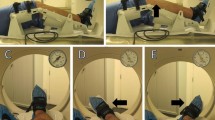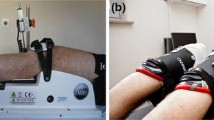Abstract
Purpose
To evaluate the diagnostic value of stress radiography and determine the cutoff values for high-grade anterolateral rotatory laxity in complete anterior cruciate ligament (ACL)-deficient knees at different positions.
Methods
Forty-two patients with complete ACL rupture (group 1) and 37 normal subjects (group 2) were prospectively enrolled. The amount of anterior translation in the medial (MM) and lateral (LL) distance compartments and the difference between them (LL-MM distance) were measured using stress radiography at 30°, 45°, 60°, and 90° positions. The area under the receiver operating characteristic curve (AUC) was assessed for the presence of a high-grade (grade > 2) pivot shift.
Results
The MM and LL distances in group 1 were significantly different at 30° and 45° positions (P < 0.05). The AUC of the MM (AUC, 0.903) and LL (AUC, 0.901) distances at the 30° position was significantly higher than that of the other positions (P = 0.000); however, the cutoff values were different to diagnose ACL injury (MM vs. LL, 3.1 mm vs. 5.4 mm). A 2.1-mm cutoff for the LL-MM distance showed 78.4% sensitivity and 90.3% specificity for detecting the presence of a high-grade pivot shift (AUC = 0.905, P = 0.000).
Conclusion
The cutoff values of stress radiography differed according to anatomical references and knee flexion positions. Stress radiography of a 2.1 mm difference in LL-MM distance at 30° of knee flexion can be a reliable method for high-grade rotatory laxity in complete ACL-injured knees.
Level of evidence
Level 1, diagnostic study.







Similar content being viewed by others
References
Bedi A, Musahl V, Lane C, Citak M, Warren RF, Pearle AD (2010) Lateral compartment translation predicts the grade of pivot shift: a cadaveric and clinical analysis. Knee Surg Sports Traumatol Arthrosc 18:1269–1276
Bedi A, Musahl V, O'Loughlin P, Maak T, Citak M, Dixon P et al (2010) A comparison of the effect of central anatomical single-bundle anterior cruciate ligament reconstruction and double-bundle anterior cruciate ligament reconstruction on pivot-shift kinematics. Am J Sports Med 38:1788–1794
Beldame J, Bertiaux S, Roussignol X, Lefebvre B, Adam JM, Mouilhade F et al (2011) Laxity measurements using stress radiography to assess anterior cruciate ligament tears. Orthop Traumatol Surg Res 97:34–43
Beldame J, Mouchel S, Bertiaux S, Adam JM, Mouilhade F, Roussignol X et al (2012) Anterior knee laxity measurement: Comparison of passive stress radiographs Telos® and “Lerat”, and GNRB® arthrometer. Orthop Traumatol Surg Res 98:744–750
Benjaminse A, Gokeler A, van der Schans CP (2006) Clinical diagnosis of an anterior cruciate ligament rupture: a meta-analysis. J Orthop Sports Phys Ther 36:267–288
Bignozzi S, Zaffagnini S, Lopomo N, Fu FH, Irrgang JJ, Marcacci M (2010) Clinical relevance of static and dynamic tests after anatomical double-bundle ACL reconstruction. Knee Surg Sports Traumatol Arthrosc 18:37–42
Bull AM, Earnshaw PH, Smith A, Katchburian MV, Hassan AN, Amis AA (2002) Intraoperative measurement of knee kinematics in reconstruction of the anterior cruciate ligament. J Bone Jt Surg Br 84:1075–1081
Cohen JF, Korevaar DA, Altman DG, Bruns DE, Gatsonis CA, Hooft L et al (2016) STARD 2015 guidelines for reporting diagnostic accuracy studies: explanation and elaboration. BMJ Open 6:e012799
Colombet P (2011) Knee laxity control in revision anterior cruciate ligament reconstruction versus anterior cruciate ligament reconstruction and lateral tenodesis: clinical assessment using computer-assisted navigation. Am J Sports Med 39:1248–1254
Colombet P, Robinson J, Christel P, Franceschi JP, Djian P (2007) Using navigation to measure rotation kinematics during ACL reconstruction. Clin Orthop Relat Res 454:59–65
Dejour H, Bonnin M (1994) Tibial translation after anterior cruciate ligament rupture. Two radiological tests compared. J Bone Jt Surg Br 76:745–749
Di Benedetto P, Di Benedetto E, Fiocchi A, Beltrame A, Causero A (2016) Causes of failure of anterior cruciate ligament reconstruction and revision surgical strategies. Knee Surg Relat Res 28:319–324
Espregueira-Mendes J, Pereira H, Sevivas N, Passos C, Vasconcelos JC, Monteiro A et al (2012) Assessment of rotatory laxity in anterior cruciate ligament-deficient knees using magnetic resonance imaging with Porto-knee testing device. Knee Surg Sports Traumatol Arthrosc 20:671–678
Fujita N, Kuroda R, Matsumoto T, Yamaguchi M, Yagi M, Matsumoto A et al (2011) Comparison of the clinical outcome of double-bundle, anteromedial single-bundle, and posterolateral single-bundle anterior cruciate ligament reconstruction using hamstring tendon graft with minimum 2-year follow-up. Arthroscopy 27:906–913
Garofalo R, Fanelli GC, Cikes A, N'Dele D, Kombot C, Mariani PP et al (2009) Stress radiography and posterior pathological laxity of knee: comparison between two different techniques. Knee 16:251–255
Georgoulis AD, Papadonikolakis A, Papageorgiou CD, Mitsou A, Stergiou N (2003) Three-dimensional tibiofemoral kinematics of the anterior cruciate ligament-deficient and reconstructed knee during walking. Am J Sports Med 31:75–79
Hoshino Y, Kuroda R, Nagamune K, Yagi M, Mizuno K, Yamaguchi M et al (2007) In vivo measurement of the pivot-shift test in the anterior cruciate ligament-deficient knee using an electromagnetic device. Am J Sports Med 35:1098–1104
Ishibashi Y, Tsuda E, Yamamoto Y, Tsukada H, Toh S (2009) Navigation evaluation of the pivot-shift phenomenon during double-bundle anterior cruciate ligament reconstruction: is the posterolateral bundle more important? Arthroscopy 25:488–495
Jacobsen K (2009) Gonylaxometry: stress radiographic measurement of passive stability in the knee joints of normal subjects and patients with ligament injuries. Acta Orthop Scand 52:9–263
Jacobsen K (2009) Stress radiographical measurement of the anteroposterior, medial and lateral stability of the knee joint. Acta Orthop Scand 47:335–344
James EW, Williams BT, LaPrade RF (2014) Stress radiography for the diagnosis of knee ligament injuries: a systematic review. Clin Orthop Relat Res 472:2644–2657
Jung YB, Jung HJ, Yang JJ, Yang DL, Lee YS, Song IS et al (2008) Characterization of spontaneous healing of chronic posterior cruciate ligament injury: analysis of instability and magnetic resonance imaging. J Magn Reson Imaging 27:1336–1340
Kim BH, Kim JI, Lee O, Lee KW, Lee MC, Han HS (2017) Preservation of remnant with poor synovial coverage has no beneficial effect over remnant sacrifice in anterior cruciate ligament reconstruction. Knee Surg Sports Traumatol Arthrosc 19:017–4683
Kim HJ, Lee HJ, Shin JY, Choi YS, Kyung HS (2017) Measurement of knee rotation angles using a smartphone application: an experimental study of porcine knees. Knee Surg Relat Res 29:302–306
Kim SH, Jung YB, Song MK, Lee SH, Jung HJ, Lee HJ et al (2014) Comparison of double-bundle anterior cruciate ligament (ACL) reconstruction and single-bundle reconstruction with remnant pull-out suture. Knee Surg Sports Traumatol Arthrosc 22:2085–2093
Kocher MS, Steadman JR, Briggs KK, Sterett WI, Hawkins RJ (2004) Relationships between objective assessment of ligament stability and subjective assessment of symptoms and function after anterior cruciate ligament reconstruction. Am J Sports Med 32:629–634
Kubo S, Muratsu H, Yoshiya S, Mizuno K, Kurosaka M (2007) Reliability and usefulness of a new in vivo measurement system of the pivot shift. Clin Orthop Relat Res 454:54–58
Kwak SG, Kim JH (2017) Central limit theorem: the cornerstone of modern statistics. Korean J Anesthesiol 70:144–156
Kwak YH, Lee S, Lee MC, Han HS (2018) Anterior cruciate ligament reconstruction with quadriceps tendon-patellar bone allograft: matched case control study. BMC Musculoskelet Disord 19:45
Lee HJ, Park YB, Kim SH (2019) Diagnostic value of stress radiography and arthrometer measurement for anterior instability in anterior cruciate ligament injured knees at different knee flexion position. Arthroscopy 35:1721–1732
Lee YS, Han SH, Jo J, Kwak KS, Nha KW, Kim JH (2011) Comparison of 5 different methods for measuring stress radiographs to improve reproducibility during the evaluation of knee instability. Am J Sports Med 39:1275–1281
Lerat JL, Moyen B, Jenny JY, Perrier JP (1993) A comparison of pre-operative evaluation of anterior knee laxity by dynamic X-rays and by the arthrometer KT 1000. Knee Surg Sports Traumatol Arthrosc 1:54–59
Lerat JL, Moyen BL, Cladiere F, Besse JL, Abidi H (2000) Knee instability after injury to the anterior cruciate ligament. Quantification of the Lachman test. J Bone Jt Surg Br 82:42–47
Lopomo N, Bignozzi S, Martelli S, Zaffagnini S, Iacono F, Visani A et al (2009) Reliability of a navigation system for intra-operative evaluation of antero-posterior knee joint laxity. Comput Biol Med 39:280–285
Lopomo N, Signorelli C, Bonanzinga T, Marcheggiani Muccioli GM, Visani A, Zaffagnini S (2012) Quantitative assessment of pivot-shift using inertial sensors. Knee Surg Sports Traumatol Arthrosc 20:713–717
Lopomo N, Signorelli C, Rahnemai-Azar AA, Raggi F, Hoshino Y, Samuelsson K et al (2017) Analysis of the influence of anaesthesia on the clinical and quantitative assessment of the pivot shift: a multicenter international study. Knee Surg Sports Traumatol Arthrosc 25:3004–3011
Lopomo N, Zaffagnini S, Amis AA (2013) Quantifying the pivot shift test: a systematic review. Knee Surg Sports Traumatol Arthrosc 21:767–783
Lopomo N, Zaffagnini S, Bignozzi S, Visani A, Marcacci M (2010) Pivot-shift test: analysis and quantification of knee laxity parameters using a navigation system. J Orthop Res 28:164–169
Lopomo N, Zaffagnini S, Signorelli C, Bignozzi S, Giordano G, Marcheggiani Muccioli GM et al (2012) An original clinical methodology for non-invasive assessment of pivot-shift test. Comput Methods Biomech Biomed Eng 15:1323–1328
Mouton C, Theisen D, Pape D, Nuhrenborger C, Seil R (2012) Static rotational knee laxity in anterior cruciate ligament injuries. Knee Surg Sports Traumatol Arthrosc 20:652–662
Mouton C, Theisen D, Seil R (2016) Objective measurements of static anterior and rotational knee laxity. Curr Rev Musculoskelet Med 9:139–147
Musahl V, Bedi A, Citak M, O'Loughlin P, Choi D, Pearle AD (2011) Effect of single-bundle and double-bundle anterior cruciate ligament reconstructions on pivot-shift kinematics in anterior cruciate ligament- and meniscus-deficient knees. Am J Sports Med 39:289–295
Musahl V, Griffith C, Irrgang JJ, Hoshino Y, Kuroda R, Lopomo N et al (2016) Validation of quantitative measures of rotatory knee laxity. Am J Sports Med 44:2393–2398
Noyes FR, Grood ES, Cummings JF, Wroble RR (1991) An analysis of the pivot shift phenomenon. The knee motions and subluxations induced by different examiners. Am J Sports Med 19:148–155
Okazaki K, Miura H, Matsuda S, Yasunaga T, Nakashima H, Konishi K et al (2007) Assessment of anterolateral rotatory instability in the anterior cruciate ligament-deficient knee using an open magnetic resonance imaging system. Am J Sports Med 35:1091–1097
Okazaki K, Tashiro Y, Izawa T, Matsuda S, Iwamoto Y (2012) Rotatory laxity evaluation of the knee using modified Slocum's test in open magnetic resonance imaging. Knee Surg Sports Traumatol Arthrosc 20:679–685
Robert H, Nouveau S, Gageot S, Gagnière B (2009) A new knee arthrometer, the GNRB®: experience in ACL complete and partial tears. Orthop Traumatol Surg Res 95:171–176
Ryu SM, Na HD, Shon OJ (2018) diagnostic tools for acute anterior cruciate ligament injury: gnrb, lachman test, and telos. Knee Surg Relat Res 30:121–127
Slocum DB, James SL, Larson RL, Singer KM (1976) Clinical test for anterolateral rotary instability of the knee. Clin Orthop Relat Res 118:63–69
Sommerlath K, Lysholm J, Gillquist J (1991) The long-term course after treatment of acute anterior cruciate ligament ruptures. A 9 to 16 year followup. Am J Sports Med 19:156–162
Suero EM, Citak M, Choi D, Bosscher MR, Pearle AD, Plaskos C (2011) Software for compartmental translation analysis and virtual three-dimensional visualization of the pivot shift phenomenon. Comput Aided Surg 16:298–303
Tashiro Y, Okazaki K, Miura H, Matsuda S, Yasunaga T, Hashizume M et al (2009) Quantitative assessment of rotatory instability after anterior cruciate ligament reconstruction. Am J Sports Med 37:909–916
Zantop T, Petersen W, Sekiya JK, Musahl V, Fu FH (2006) Anterior cruciate ligament anatomy and function relating to anatomical reconstruction. Knee Surg Sports Traumatol Arthrosc 14:982–992
Funding
The authors report no financial disclosure.
Author information
Authors and Affiliations
Corresponding author
Ethics declarations
Conflict of interest
The authors report no conflicts of interest.
Ethical approval
Ethical approval for this study was obtained from the Institutional Review Board of Chung-Ang University hospital (No. 1711–007-16117).
Additional information
Publisher's Note
Springer Nature remains neutral with regard to jurisdictional claims in published maps and institutional affiliations.
Electronic supplementary material
Below is the link to the electronic supplementary material.
Rights and permissions
About this article
Cite this article
Kim, S.H., Park, YB., Ham, DW. et al. Stress radiography at 30° of knee flexion is a reliable evaluation tool for high-grade rotatory laxity in complete ACL-injured knees. Knee Surg Sports Traumatol Arthrosc 28, 2233–2244 (2020). https://doi.org/10.1007/s00167-019-05803-w
Received:
Accepted:
Published:
Issue Date:
DOI: https://doi.org/10.1007/s00167-019-05803-w




